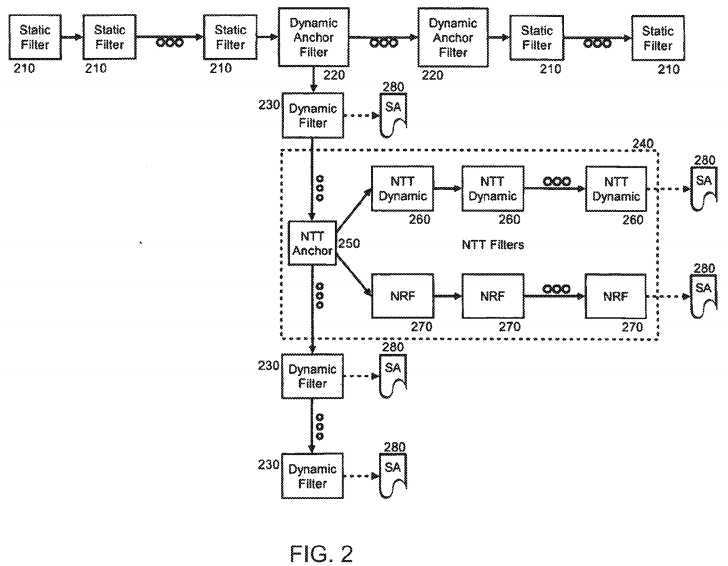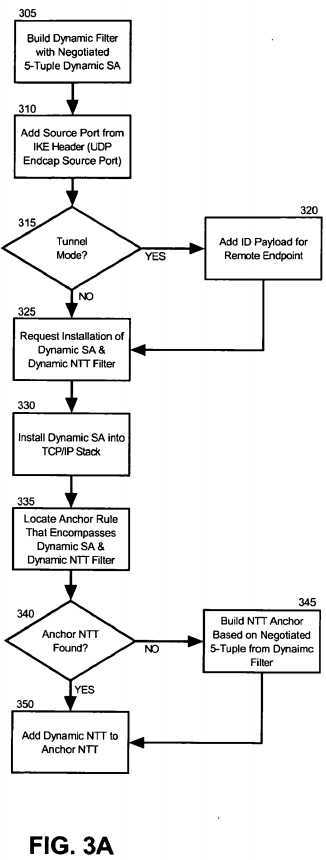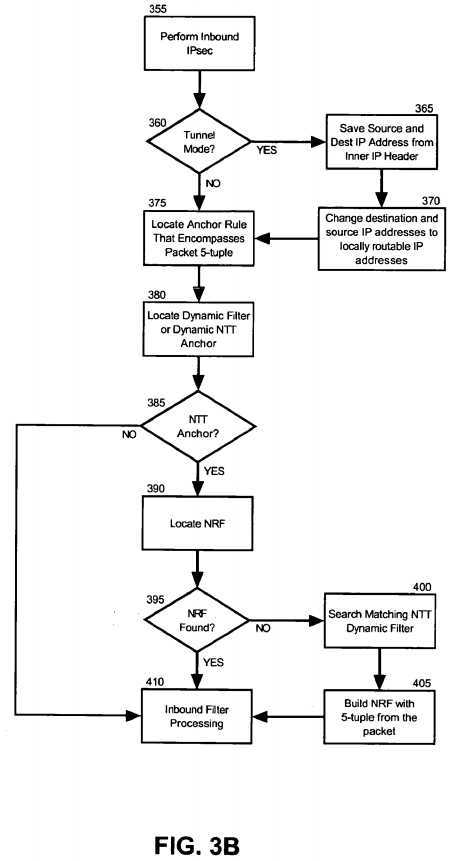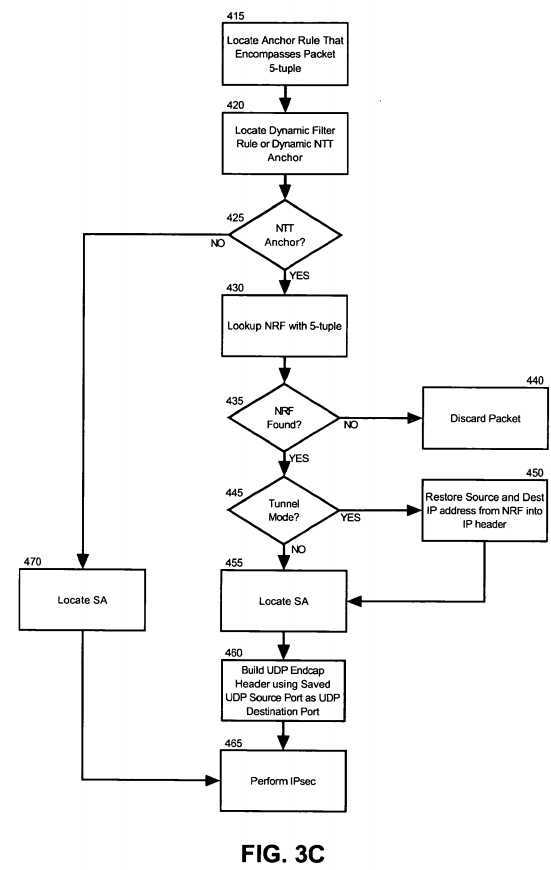标签:des style blog http color os strong io
Embodiments of the present invention address deficiencies of the art in respect to secure communications for multiple hosts in an address translation environment and provide a method, system and computer program product for IPsec SA management for multiple clients sharing a single network address. In one embodiment, a computer implemented method for IPsec SA management for multiple hosts sharing a single network address can include receiving a packet for IPsec processing for a specified client among the multiple clients sharing the single network address. A dynamic SA can be located among multiple dynamic SAs for the specified client using client identifying information exclusive of a 5-tuple produced for the dynamic SA. Finally, IPsec processing can be performed for the packet.
The present invention relates to the field of secure forms of computer communications and more particularly to secure forms of computer communications for multiple clients sharing a single network address.
Internet security has increasingly become the focus of information technologists who participate in globally accessible computer networks. In particular, with the availability and affordability of broadband Internet access, even within the small enterprise, many computers and small computer networks enjoy continuous access to the Internet. Notwithstanding, continuous, high-speed access is not without its price. Specifically, those computers and computer networks which heretofore had remained disconnected from the security risks of the Internet now have become the primary target of malicious Internet hackers, crackers and script kiddies, collectively referred to as "malicious hackers".
Notably, many such unauthorized intruders continuously scan the Internet for Internet Protocol (IP) addresses and ports of vulnerable computers communicatively linked to the Internet. At the minimum, those vulnerable computers can experience nuisance damage such as accessed, deleted or modified files or defaced Web pages. Yet, at the other extreme, for the unsuspecting end-user their computer can become the staging area for "zombies" with which more malicious attacks can be launched resulting in the crippling of whole segments of the Internet.
To address the vulnerability of computing devices exposed to the global Internet, information technologists have deployed network address translation (NAT) and network port address translation (NAPT) technologies deployed as a firewall. NAT technologies map a publicly known network address to a privately known address within a private network. In this way, external intruders cannot directly access private network devices as the private network address can be shielded from the external intruder through the proxy action of NAT. The use of NAT, however, requires a one-to-one correspondence between private and public address. To economize on the cost of a single public network address (which can be expensive), a NAPT configured firewall can act similarly to NAT excepting that a single public address can map to multiple private devices which can be distinguished by unique port assignments behind the firewall.
While NAPT and NAT enable security for devices behind the firewall, NAPT and NAT can do little to secure data in transit between source and destination nodes in the Internet. To provide true, end-to-end security for data in the Internet, secure communications must be employed. The Internet Security Protocol, known in the art as "IPsec" represents a common form of secure communications for use over the Internet. In IPsec, communications between source and destination nodes in the Internet can be administered in accordance with a security association (SA). An SA can include one or more rules that define the IPsec processing that is applied to the communication. IPsec is defined in the Request for Comment (RFC) 2401 among other RFCs.
In IPsec, whether the transmission of a packet is denied or permitted with or without IPsec processing is determined by matching the attributes of a packet within the security rules in a security policy database (SPD). To make this determination, both the static rules of a security policy and dynamic rules negotiated as part of an Internet Key Exchange (IKE), each which refers to an SA as described in RFC 2401, can be subjected to a filtered search in the order of most specific to least specific attributes for both outgoing and incoming packets. The filtering of the attributes of a packet within the security rules can be based upon the source and destination address for the paired nodes engaging in secured communications.
For a more complete explanation of the filtering process, U.S. Pat. No. 6,754,832 to Godwin et al. for SECURITY RULE DATABASE SEARCHING IN A NETWORK ENVIRONMENT (Godwin) describes in detail the process of locating a security rule during IPsec processing. Specifically, as described in Godwin, IPsec rules are filtered according to attributes assigned to the rules. The attributes include the source Internet Protocol (IP) address, destination IP address, source port, destination port and protocol. Each dynamic rule contained in the dynamic rules specifies values for all five attributes, hereinafter referred to as the 5-tuple. The static rules include placeholders for sets of dynamic rules. Dynamic rules generally can be searched only if a placeholder is the first matching rule in the static table.
The base standard for applying IPsec with NAT traversal is described in RFC 3947 and RFC 3948. In these documents, a general incompatibility is discussed as between IPsec and NAT traversal. Yet, a more specific inability of IPsec and NAT traversal to support the processing of multiple SAs from multiple clients with the same 5-tuple follows. In particular, inasmuch as IPsec filters the attributes of a packet within security rules in an SPD based upon the source and destination address for paired nodes, the sharing of a single network address for a node can produce ambiguities in the filtering process as SAs for different clients behind an NAPT platform can produce the same 5-tuple.
Embodiments of the present invention address deficiencies of the art in respect to secure communications for multiple clients in an address translation environment and provide a novel and non-obvious method, system and computer program product for IPsec packet processing for multiple clients sharing a single network address. In one embodiment, a computer implemented method for IPsec packet processing for multiple clients sharing a single network address can include receiving a packet for IPsec processing in association with a specified client among the multiple clients sharing the single network address. A dynamic filter rule can be located among multiple dynamic filter rules for the specified client using client identifying information exclusive of a 5-tuple produced for the dynamic filter rule, for instance using a user datagram protocol (UDP) encapsulating source port for the specified client. Finally, IPsec processing can be performed for the packet using the located dynamic filter rule.
Receiving a packet for IPsec processing in association with a specified client among the multiple clients sharing the single network address can include receiving an inbound packet for IPsec inbound processing for a specified client among the multiple clients sharing the single network address, extracting the UDP encapsulating source port from the packet, and storing the UDP encapsulating source port from the packet in association with a filter for the dynamic filter rule. As such, the method also can include receiving an outbound packet for IPsec outbound processing for the specified client, determining a 5-tuple for the outbound packet, locating a plurality of dynamic SAs for the 5-tuple, and selecting one of the dynamic SAs based on the selection of a NAT resolution filter (NRF) which has a 5-tuple that exactly matches the 5-tuple of the packet and which is associated with the dynamic SA.
In another embodiment, a data processing system for IPsec packet processing for multiple clients sharing a single network address can include a security policy database (SPD) and IPsec processing logic coupled to the SPD wherein the IPsec processing logic includes program code enabled to permit multiple dynamic filter rules for the different clients. Optionally, the IPsec processing logic further can be coupled to a host computing device. Alternatively, a gateway can be provided for multiple, different host computing devices, wherein the IPsec processing logic can be further coupled to the gateway for the different host computing devices.
Notably, the system further can include SA resolution logic coupled to the IPsec processing logic. The SA resolution logic can include program code enabled to receive packets for IPsec processing for specified clients among the multiple different clients sharing the single network address, locate a single dynamic SA among a plurality of dynamic SAs for each of the specified clients using client identifying information exclusive of a 5-tuple produced for the dynamic SAs, and perform IPsec processing of the received packets. In this regard, the client identifying information can include a UDP encapsulating source port for each of the specified clients.
Additional aspects of the invention will be set forth in part in the description which follows, and in part will be obvious from the description, or may be learned by practice of the invention. The aspects of the invention will be realized and attained by means of the elements and combinations particularly pointed out in the appended claims. It is to be understood that both the foregoing general description and the following detailed description are exemplary and explanatory only and are not restrictive of the invention, as claimed.
Embodiments of the present invention provide a method, system and computer program product for IPsec packet processing for multiple clients sharing a single network address in an address translation environment. In accordance with an embodiment of the present invention, a dynamic filter rule can be located among multiple dynamic filter rules for different clients sharing a single network address in an address translation environment by referring to a client identifier produced by the IPsec process. In particular, the UDP encapsulating source port produced during IPsec processing for inbound and outbound packets can be used to differentiate between multiple dynamic filter rules for corresponding different clients sharing a single public network address. As a result, IPsec can coexist with NAPT without falling victim to the ambiguities of multiple clients sharing a single public network address in an address translation environment.
In further illustration,?FIG. 1?is a schematic illustration of an address translation environment configured for IPsec packet processing for multiple clients sharing a single network address. The address translation environment can include two or more hosts?130?communicatively coupled to one or more client computing devices?110?utilizing NAPT behind NAPT device?140?and router/gateway?150?in a private computer communications network?120A. The hosts?130?and the client computing devices?110?can be configured to securely communicate with one another over a public computer communications network?120B, for example the global Internet.

Secure communications can be enabled through the operation of client side IPsec processing logic?100?cooperatively engaged with server side IPsec processing logic?160. In IPsec transport mode, the IPsec processing logic?100can be associated with the client computing devices?110. By comparison, in IPsec tunnel mode, the IPsec processing logic?100?can be associated with the router/gateway?150?for the client computing devices?110.
The server side IPsec processing logic?160?can be disposed within or in association with one or more of the hosts?130?as shown in?FIG. 1, or with a gateway platform (not shown) for one or more of the hosts?130. To facilitate the application of security rules in IPsec processing incoming and outgoing packets, an SPD?180?can be coupled to the IPsec processing logic?160. The SPD?180?can reference one or more SAs?190?defining security rules to be applied during IPsec processing. Notably, SA resolution logic?300?further can be coupled to the IPsec processing logic?160. The SA resolution logic?300?can include program code enabled to select a particular SA from among the SAs?190?for a particular one of the client computing devices?110?behind the NAPT platform?140.
To enable the selection of a particular SA from the among the SAs?190?for a particular one of the client computing devices110?behind the NAPT platform?140, the SA resolution logic?300?can be coupled to one or more dynamic filter rules installed in a stack for a negotiated SA, referred to herein as NAT traversal (NTT) filter rules?300A. In this regard, there is a one-to-one mapping between NTT filter rules?300A and matching dynamic SAs?190. The SA resolution logic?300?further can be coupled to one or more placeholder dynamic filter rules referred to herein as NTT anchors?300B. Each NTT anchor?300B can match a 5-tuple and can be associated with one or more NTT filter rules?300A matching the 5-tuple. Finally, the SA resolution logic?300?yet further can be coupled to a NAT resolution filter (NRF) table?170. Importantly, the NRF table?170can store differentiating information for resolving different ones of the NTT filter rules?300A which match a provided 5-tuple.
In operation, restrictions on IPSec SAs for the multiple client computing devices?110?behind the NAPT platform?140?which share a single public address can be lifted and the IPsec processing logic?160?can be permitted to engage in IKE for IKE peers among the client computing devices?110?having different IKE UDP source ports. The SA resolution logic?300?can be enabled to store differentiating information for each of the client computing devices?110?associated with a negotiated SA during IKE in an NTT filter rule?300A along with a conventional 5-tuple for the packet which can include the source IP address, destination IP address, source port, destination port and protocol. The differentiating information can include, for example, the UDP encapsulating port for each packet, and the differentiating information can be stored in the NRF table?170so that using the differentiating information, an NTT filter rule?300A can be resolved for a particular one of the client computing devices?110?behind the NAPT platform?140?even though the 5-tuple can resolve to multiple, different SAs for different ones of the client computing devices?110.
To support the resolution of multiple NTT filter rules?300A which match a given 5-tuple, the SPD?180?can be arranged to have an architecture which accommodates the entries of the NRF table?170, the NTT filter rules?300A and the NTT anchors300B. In more specific illustration,?FIG. 2?is a block diagram of an SPD architecture configured for IPsec packet processing for multiple clients sharing a single network address in the address translation environment of?FIG. 1. As shown in?FIG. 2, the SPD architecture can include one or more static filter rules?210?arranged in a data structure. One or more dynamic anchor filters?220?can be disposed among the static filter rules?210?as placeholders for one or more dynamic filters?230.

Each dynamic anchor filter?220?can point to a data structure of one or more dynamic filters?230?which reference corresponding SAs?280. Notably, the dynamic filters?230?can include an NTT composite structure?240. The NTT composite structure?240?can include an NTT anchor?250?which can point to a data structure of one or more NTT filter rules?260?and also one or more NRF entries?270?in an NRF table, each of the NTT filter rules?260?and NRF entries?270?also resolving to corresponding SAs?280. Using the foregoing arrangement, a specific NRF entry?270?including differentiating information can be located for a 5-tuple which resolves to multiple SAs. Using the differentiating information, a specific one of the SAs?280for a 5-tuple can be identified.
More specifically, during inbound filter processing, the UDP source port from an encapsulating UDP packet is known. Therefore, the UDP source port can be used to determine a correct one of the inbound NTT filter rules?260. The search order through the filter table can include first locating a matching dynamic anchor filter rule?220?based on the 5-tuple for the packet. Secondly, a matching NTT anchor?250?can be located based upon the 5-tuple. Thirdly, an NTT filter rule?260?can be located using the 5-tuple and the UDP source port. Finally, the UDP source port can be stored in an NRF entry?270?for the 5-tuple for use during outbound filtering where the UDP source port is not known a priori. Notably, for each unique 5-tuple received in a packet during inbound processing. a new NRF can be built. Since an SA can be used by packets with different 5-tuples, and since there is a one-to-one relationship between an NTT filter rule and a dynamic SA, more than one NRF can be associated with each NTT filter rule.
In more particular illustration,?FIGS. 3A through 3C, taken together, are a flow chart illustrating a process for IPsec packet processing for multiple clients sharing a single network address in the address translation environment of?FIG. 1. Referring initially to?FIG. 3A, an IPsec process is shown for populating the stack with dynamic anchor filter rules and NRF entries according to the SPD architecture of?FIG. 2. Beginning in block?305, a dynamic NIT filter can be built with a 5-tuple from the dynamic SA negotiated during IKE. In block?310, the UDP encapsulating source port can be identified from the IKE header and added to the dynamic NTT filter. In decision block?315, if tunnel mode has been established for the IPsec process, in block?320, the identifying payload for the remote endpoint can be added to the dynamic SA. Subsequently, in block?325, a request can be generated for the TCP/IP stack to install the dynamic SA and a dynamic NTT filter for the dynamic SA in the stack, and in block?330, the dynamic SA can be installed in the stack.



Subsequent to SA negotiation by IKE, during the TCP/IP stack dynamic SA and dynamic NTT filter installation processing, in block?335, an anchor rule can be located that encompasses the dynamic SA and the dynamic NTT filter. In decision block340, if an NTT anchor rule can be located for the dynamic SA, in block?350?the dynamic NTT can be added to the located NTT anchor rule. Otherwise, in decision block?340, if an NTT anchor rule cannot be located for the dynamic SA and dynamic NTT filter, in block?345?an NTT anchor rule can be built based upon the negotiated 5-tuple from the dynamic filter. Finally, in block?350, the dynamic NIT can be added to the NTT anchor rule.
Turning now to?FIG. 3B, a flow chart is shown illustrating inbound packet processing utilizing the dynamic anchor filter rules and dynamic NTT filter entries in the stack. Beginning in block?355, inbound IPsec can be performed. In decision block?360, if tunnel mode has been established, in block?365?the source and destination IP addresses from the inner IP header of the packet can be saved. Also, in block?370?the destination IP address in the inbound packet can be changed to a locally routable IP address if host?130?is behind a NAT. For instance, the locally routable IP address can be obtained from the destination IP address in the outer header if the data traffic endpoint is the SA endpoint. Also, in block?370?the source IP address in the packet can be changed to a locally routable IP address if client?100?is behind a NAPT. For instance, the locally routable source IP address can be obtained from the outer header.
In block?375, an NTT anchor rule can be located in the stack that encompasses the 5-tuple from the packet. Also, in block380, a dynamic filter or dynamic NIT anchor can be located that encompasses the 5-tuple from the packet. In decision block385, if an NTT anchor can be located, the IPsec peer is located behind a NAPT platform and in block?390, an NRF entry can be located in the NRF table. In decision block?395, if an NRF entry cannot be located, in block?400?a matching NTT dynamic filter can be located using the 5-tuple and the UDP encapsulated source port. In block?405, an NRF entry can be constructed using the 5-tuple and the UDP encapsulating source port of the packet. The NRF is also constructed to reference the SA that is referenced by the matching NTT dynamic filter and also the saved source and destination addresses from the inner IP header. Finally, in block?410, inbound filter processing can commence.
Finally,?FIG. 3C?is a flow chart which illustrates outbound packet processing utilizing the dynamic anchor filter rules and NRF entries in the stack. Beginning in block?415, an anchor rule can be located that encompasses the 5-tuple of the outbound packet. In block?420, a dynamic filter rule or a dynamic NTT anchor can be located for the anchor rule. In decision block425, if a dynamic NTT anchor is not located, in block?470, the dynamic SA for the dynamic filter can be retrieved and IPsec can be performed on the packet in block?465. Otherwise, the process can continue through block?430.
In block?430, an NRF entry can be located for the dynamic NTT anchor using the 5-tuple. In decision block?435, if an NRF entry cannot be located, in block?440?the packet can be discarded. Otherwise, in decision block?445, if tunnel mode has been established, in block?450?the IP source and destination addresses from the NRF entry can be restored into the IP header. In block?455, an SA can be located for a host associated with the located NRF entry. Subsequently, a UDP encapsulating header can be constructed in block?460?using the UDP encapsulating source port from the NRF entry as the destination port. Finally, in block?465, IPsec processing can be performed on the packet.
Thus, it will be apparent that on inbound processing, an SA can be selected among multiple SAs for different clients sharing a single network address in an address translation environment by referring to the UDP encapsulating source port produced by the IPsec process. Also, on outbound processing, an SA can be selected among multiple SAs for different clients sharing a single network address in an address translation environment by referring to an NRF entry located in association with a 5-tuple for an outbound packet. As a result, IPsec can coexist with NAPT despite the ambiguities of identical 5-tuples produced for multiple clients sharing a single public network address in an address translation environment.
SRC=http://www.google.com/patents/US20130013915
标签:des style blog http color os strong io
原文地址:http://www.cnblogs.com/coryxie/p/3891316.html